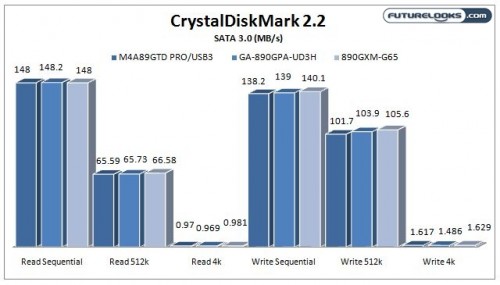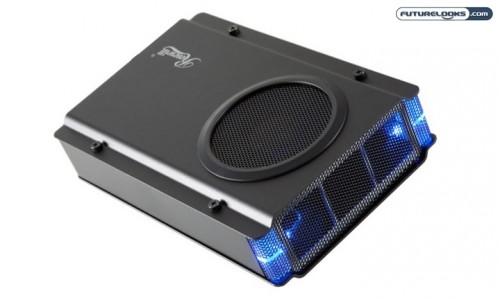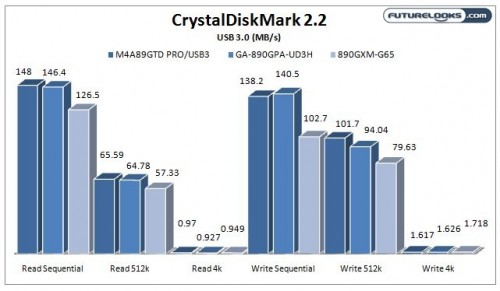CrystalDiskMark 2.2 – SATA 3.0
First up is the SATA 3.0 performance of our boards. SATA 3.0 (aka SATA 6Gbps) is part of the 890GX chipset and is built right into the SB850 southbridge. We check out the single drive performance of the controller using the Seagate Barracuda XT 2TB drive in our parts arsenal. We expect the results to be pretty much uniform across all of the motherboards seeing as every board uses the same chipset.

As expected, the results are pretty much uniform right across the board. Any dips and spikes are pretty minute percentage wise and they won’t be things that you can feel in the real world. The MSI continues to be strong overall which reflects what we found out in the PCMark Vantage x64 benchmark. The GIGABYTE seems to swap spots with the ASUS on a couple of the tests.
CrystalDiskMark 2.2 – USB 3.0

The USB 3.0 is something we said that we’d shine a light on. This is mainly because USB 3.0 support is optional for the 890GX chipset. In fact, ASUS actually manufacturers a version of the M4A89GTD PRO/USB3 without the USB3 and sells it for a few dollars cheaper. The other reason why we wanted to shine a light on USB 3.0 was because we found two distinct versions of the NEC USB 3.0 chip: one made in China (on the ASUS) and one made in Japan (fitted to the MSI and GIGABYTE).

In order to test USB 3.0 performance, we inserted our Seagate Barracuda XT 2TB SATA 3.0 drive into the Rosewill RX358 USB 3.0 Enclosure. This product retails for around $69.99US and provides a pretty good value, allowing you to turn any hard drive into a USB 3.0 compatible one. Keep in mind that your hard drive selection will impact performance. The box is built well and offers both active cooling (or passive if you turn off the fan via an external switch). The box lights up blue and is powered by an external adapter. A USB 3.0 cable is also provided to get you going and assembly is super easy, even without instructions (which are provided anyway). You’ll be seeing this enclosure a lot this year as we rip through our list of board reviews and you can pick up your own at Amazon.

The ASUS and GIGABYTE implementations seem pretty solid, and both boards seem to swap places depending on the test. The MSI however falls short in the sequential read and write tests and 512k tests, but pops back up a bit in the 4k read and write tests somewhat. What we’ve learned here is that whether the chip comes from China or Japan, performance doesn’t seem to be an issue. To explain the large lead that the ASUS and GIGABYTE have over the MSI board, I can only point to a couple things.
GIGABYTE’s USB 3.0 implementation is coupled with some 3X powered USB slots. I can only wonder if this extra boost in power could be responsible for the performance gain. The performance on the ASUS points back to the controller inside the Rosewill RX358 enclosure. What I found out is that inside the enclosure is a chip made by “ASMEDIA” which is actually a division of ASUS. I’m not 100% sure, but this could be why the ASUS puts up a fight with the GIGABYTE and leaves the MSI behind as well. I’d like to get an enclosure without a controller made by ASUS to see if the board still performs, but we’ll leave that for another article. At this point, they are just theories as to why theses differences exist.
Needless to say, there does seem to be some variance in performance when it comes to USB 3.0 implementation and some of the gaps are quite substantial. If this is important to you then you’ll want to keep an eye on these benchmarks when picking up the board you want.
